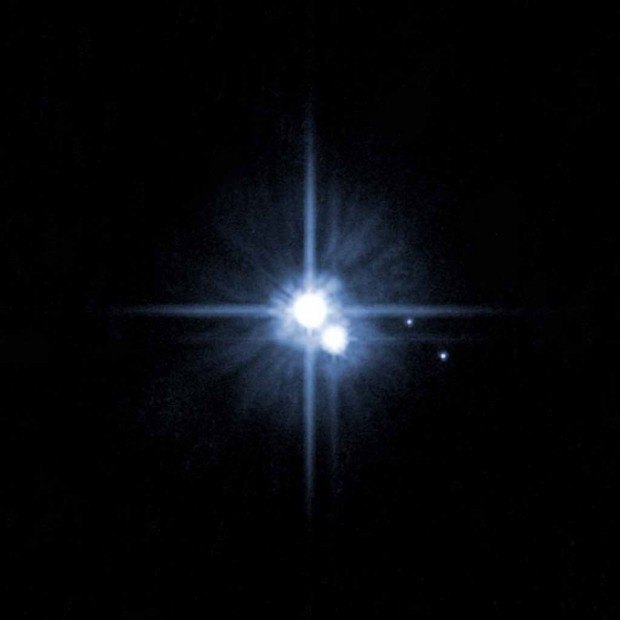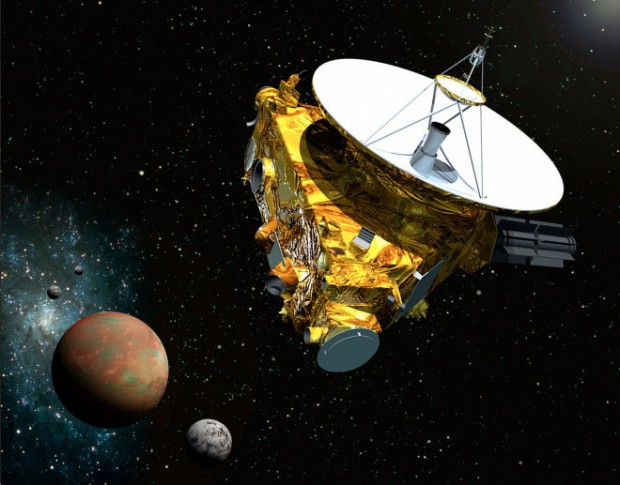نخستین فضاپیمایی که به دیدار پلوتو میرود، سه روز دیگر از خواب برمیخیزد. فضاپیمای «افقهای نو، New Horizons» طی ۹ سال گذشته بیش از چهار میلیارد کیلومتر را به سوی پلوتو در حرکت بوده است.
در این مدت فضاپیما برای ذخیرهی انرژی بهطور متناوب به خواب زمستانی فرو رفته است بهطوریکه در مجموع تقریباً ۵ سال از این سفر را در خواب بوده است. هنگام خواب همهی ابزارهای آن کاملاً خاموشاند به جز اینکه هر از گاهی با فرستادن سیگنالی به سوی زمین، به افراد پروژهی افقهای نو سلامتی خود را خبر میدهد.
اما تا سه روز دیگر افقهای نو برای آخرین بار از خواب زمستانی برمیخیزد تا برای رسیدن به پلوتو در تیر ماه سال آینده آماده شود. ابزارهای فضاپیما روز ۶ دسامبر/۱۵ آذر در ساعت ۸ شب به وقت گرینویچ دوباره شروع بهکار خواهند کرد. یک ساعت و نیم بعد فضاپیما سیگنالی را بهسوی زمین میفرستد که با توجه به فاصلهی کنونی آن با زمین تقریباً بیش از ۴ ساعت بعد پیام به اتاق کنترل خواهد رسید. پس از آن شش هفته همهی ابزارها چک و آماده خواهند شد تا افقهای نو به سوی سیارهی کوتوله حرکت کند و در ۱۴ جولای/ به نزدیکترین فاصلهاش از پلوتو خواهد رسید.

تصویر گرفته شده توسط تلسکوپ فضایی هابل در سال 2006 از سیاره پلوتو و قمرهایش ( Charon, Nix, و Hydra )
هنگامیکه در دی ماه سال ۱۳۸۵/۲۰۰۶ افقهای نو به فضا پرتاب شد، هنوز پلوتو سیارهی منظومهی شمسی بود اما در همان سال اتحادیهی بینالمللی نجوم (IAU) آن را در دستهی سیارههای کوتوله قرار داد و تعداد سیارات منظومهی ما از ۹ به ۸تا تغییر کرد. در آن زمان پلوتو سه قمر داشت: کارن در سال ۱۹۷۸/۱۳۵۷، نیکس و هیدرا در سال ۲۰۰۵/۱۳۸۴ کشف شده بودند. اما سه سال پیش دو قمر دیگر با نامها کربروس و استیکس کشف شدند و موقعیت جدیدی برای اکتشاف بیشتر پیش روی افقهای نو قرار دادند.
منبع : wired
Spacecraft Bound for Pluto Prepares for Its Close Encounter
Spacecraft Bound for Pluto Prepares for Its Close Encounter
The first spacecraft to ever visit Pluto is set to wake up on Dec. 6 in preparation for its midsummer rendezvous with the solar system’s most famous dwarf planet.
The New Horizons spacecraft has been speeding toward Pluto for almost nine years, covering 2.9 billion miles. To conserve energy and general wear and tear, the spacecraft has gone into intermittent hibernation, often for months at a time, slumbering for a total of five years. When sleeping, it was almost completely shut down, maintaining only enough power to send a weekly beep home telling mission controllers that it’s doing fine.
But now it’s go time.
The spacecraft’s systems are programmed to start up again on Dec. 6 at 12:00 p.m. PST/3:00 p.m. EST. An hour and a half later, it will send a signal back to Earth confirming that it’s awake. But because it’s so far away, it will take more than four hours for the message to reach mission control—around 6:30 p.m. PST/9:30 p.m. EST. Mission controllers will then take six weeks to check all of the spacecraft’s systems and prepare its approach toward Pluto, which starts in earnest on January 15, 2015.
When New Horizons launched in January 2006, Pluto was still considered a full-fledged planet, the only one not to have been visited by any spacecraft. But later that year the International Astronomical Union vote to reclassify Pluto as a dwarf planet.
At the time of launch, Pluto was known to have three moons: Charon, discovered in 1978, and Nix and Hydra, spotted in 2005. Then in 2011 and 2012, scientists found two more, Kerberos and Styx, respectively, giving New Horizons even more places to explore. One of the mission’s goals is see whether Pluto has any more companions, and if it has a ring system. Astronomers using the Hubble Space Telescope haven’t seen anything yet, but that doesn’t mean there aren’t moons and rings too small and faint to detect.
More moons and a ring system would certainly be exciting. But they could also be bad news, says Simon Porter, a planetary scientist at the Southwest Research Institute in Tucson, Arizona, who’s on the New Horizons science team. If there are smaller, yet-to-be-detected moons, then they likely have been struck by all sorts of other tinier objects, like baseball-sized space rocks. Those collisions would have kicked up dust that could escape the gravity of its moon, but not the Pluto system. That means there could be a lot of dust floating around, posing a hazard to New Horizons.
From the spacecraft’s point of view, the millimeter-wide dust particles would be space bullets, zipping by at almost 30,000 miles per hour with enough force to do some major damage.
The New Horizons team is especially worried because the spacecraft itself will be chock full of exciting data. As it flies by Pluto, it will save all of its images and measurements onboard before sending them back to Earth (there will be so much data that it will take until late 2016 to finish transferring). If something happens to the spacecraft, all that information could be lost.
Fortunately, Porter and his colleagues have been scoping out the Pluto system. In addition to analyzing Hubble images, they’re running computer simulations to assess the potential dangers posed by hypothetical moons placed in various orbits. So far, they don’t see anything that could threaten New Horizons. But the worry is in the unexpected. “The concern is from dust from satellites that we don’t know about,” he said. New Horizons won’t be close enough to Pluto to really assess the threat until late April. But even if there are unknown moons, the spacecraft might still be safe because its current trajectory takes it through areas that shouldn’t be too dusty based on the physics of the system, Porter explains.
In the worst-case scenario, and New Horizons finds itself in perilous space, the team can position the piano-sized spacecraft so that its nearly 7-foot-wide dish antenna acts as a shield. The team can also change the trajectory of the craft so that it flies by Pluto at a greater distance, farther from any dangerously dusty regions. That would limit the resolution of the images, and if the spacecraft has to orient its dish antenna to act as a shield, then it can’t point some of its instruments at Pluto, which means it can’t collect as much data as scientists hope, Porter says. But at least the spacecraft would be safe.
Despite the risks, the mission is poised to return a glut of discoveries, continuing the legacy of the first planetary spacecraft: the Mariner missions that visited Mercury, Venus, and Mars in the 1960s and 1970s, and the Voyager missions that explored the outer planets in the 1980s. Those missions were pioneers, as nearly every image and measurement revealed fantastic worlds never seen before.
“Every time in the past we’ve had a first look at a new system, we’ve been surprised,” said Will Grundy, a planetary scientist at Lowell Observatory in Flagstaff, Arizona, and a member of the mission’s science team.
To date, the best image of Pluto (below), taken by Hubble, shows a blurry disk. Starting in the spring, New Horizons will reveal an icy world with a wispy atmosphere, possible polar ice caps, and maybe even mountains and cryogenic volcanoes and geysers that spew nitrogen or some ammonia-water blend, similar to the ones that might exist on Charon.
Telescopes reveal that Pluto’s surface has the chemical signatures of compounds such as methane, nitrogen, and carbon monoxide. It’s so cold there—an average of about -380 degrees Fahrenheit—that all those chemicals are frozen. But they are volatile substances and could be subject to all kinds of chemical and geological processes, meaning that Pluto’s surface could be fairly active, Grundy says.
Yes, Pluto is “merely” a dwarf planet now, but that doesn’t seem to matter to mission scientists. They all refer to Pluto as a planet, Grundy says, partly because that’s what they’ve always known it to be and partly because it’s “shorthand for a big round thing.” At a press conference on Nov. 13, New Horizons project scientist Hal Weaver pointed out that the term “dwarf planet” still has the name “planet” in it.
Pluto is one of the largest objects in the Kuiper belt, a collection of cold bodies beyond the orbit of Neptune and the last frontier of the solar system. The first Kuiper belt object wasn’t discovered until 1992. There are now more than 1,000 known Kuiper belt objects, and scientists estimate there are hundreds of thousands of them.
These objects have been around since the formation of the planets, so they serve as relics that help researchers understand the history and origin of the solar system. And Pluto contains clues about these ancient, icy bodies. For example, any craters on its surface will help scientists estimate how frequently Kuiper belt objects slammed into one another in the past, Grundy says.
Today, New Horizons is still 175 million miles from Pluto, but by mid-April, it will be close enough that its images will surpass those taken by Hubble.
“Then it gets better and better and better,” Weaver said at the November press conference. By June and July, New Horizons will be close enough to study Pluto’s geology. “We’ll have lots of juicy science—historic science—well before the day of the closest approach,” he said.
That day of closest approach is July 14, 2015, when the spacecraft will be only about 6,200 miles from Pluto, zipping by at about 31,300 miles per hour. Its high-resolution cameras will be able to pick out surface details 230 feet wide, which, at the same distance from Earth, would be equivalent to identifying the ponds in New York City’s Central Park, according to planetary scientist Alan Stern of the Southwest Research Institute, who’s leading the mission.
The rendezvous with Pluto will last six months, and New Horizons will map the geology, temperature, and composition of Pluto and its moons, and analyze the Plutonian atmosphere. As New Horizons leaves the Pluto system, it will glance back at Pluto passing in front of the sun to see whether there’s a haze above the atmosphere—a feature that was also seen on Neptune’s moon Triton, which is similar to Pluto in size, atmosphere, and surface composition. New Horizons may also discover a comet-like tail of particles streaming off Pluto.
Even when New Horizons leaves the Pluto system, it’s not quite done. In October, astronomers used Hubble to identify three smaller Kuiper Belt Objects that New Horizons could visit in around 2019. But whether the spacecraft will make the extra visit depends on its post-Pluto condition and NASA funding.
 گجت نیوز آخرین اخبار تکنولوژی، علم و خودرو
گجت نیوز آخرین اخبار تکنولوژی، علم و خودرو 








